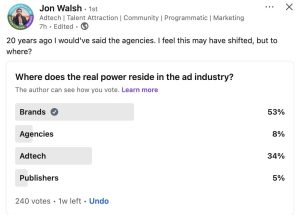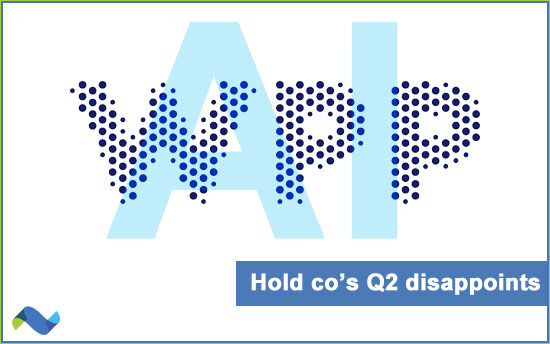AGENCIES
WPP disappoints: Will Lesser ‘catch a falling knife’?
WPP reported disappointing Q2 earnings yesterday and shares of the agency holding company dropped more than 15%, reducing its market cap to $6.3 billion. Get the WPP earnings release.
The Wall Street Journal reported:
“The company said Wednesday its performance in North America has deteriorated since the first few months of the year, while other regions have remained weak. Lower client spending and a drop in new business is hitting its Ogilvy agency and its media buying unit, WPP Media, in particular.”
”It expects a year-on-year decline in headline operating profit margin of between 0.5 percentage points and 1.75 percentage points in 2025, from previous guidance of around flat.”
”Since the start of the year, we have faced a challenging trading environment with macro pressures intensifying and lower net new business,’ WPP CEO Mark Read said.”
Read more in The WSJ (July 9).
Thought bubble: Many have projected that WPP Media CEO Brian Lesser will take over the reigns at WPP when Read’s tenure ends in December. Given the AI/data/tech-driven future in agency services, Lesser’s experience seems like a perfect match.
But, will he want to “catch a falling knife?”
In fact, if Mr. Lesser doesn’t get (or take) the job, that could be seen as another signal regarding the deterioration of WPP’s business.
How the InfoSum acquisition by WPP in April plays into his decision is another angle to all this. Lesser had been CEO of the data clean room company prior to his CEO role at WPP Media (was GroupM).
BRANDS
Hey marketers, it’s about relationships
In an op-ed on The Trade Desk’s publication, The Current, Heather Carver of Freestar and Vanessa Otero of Ad Fontes Media take a dim view of AI and marketers’ brand safety concerns around news. They believe it’s at the expense of quality journalism.
The two argue publishers’ trusted relationships with consumers are what marketers should care about:
“As AI further distorts how people discover information, direct relationships with trusted news sources will become more valuable. Though many news sites have seen their SEO-related traffic fall, many news publications have made up that traffic in direct visits, indicating that the Q&A format of AI search doesn’t necessarily meet all the needs of news readers. These readers intentionally seek out journalism — making them ideal targets for brands seeking relevance and trust.”
“Buy ads on my news site…” says this sell-side POV on an ad tech company’s website.
Read “How the ad ecosystem penalizes quality journalism — and what comes next.” (July 9)
BRANDS
AI turns sheriff in pharma ads ‘’Wild West’
By using AI, the Advertising Standards Authority (ASA) in the UK was able to track down a “‘Wild West’ culture of online selling” in the pharmacy vertical.
The Guardian reported on July 8:
“The ASA said its AI monitoring resulted in it processing 28m ads across all sectors in 2024, with 94% of those that were amended or withdrawn coming from the AI system.”
”The regulator said its AI system would continue to search for problem ads, helping the body identify repeat offenders. It has already identified more than 20,000 ads from 35 high priority pharmacies between February and June this year, 10,000 of which were for weight loss treatments.”
The findings have enabled the ASA to create nine new rulings that set “clear precedents for online selling” by the pharma industry in the UK.
BRANDS
Who has the power in the age of AI?
In an impromptu poll on LinkedIn yesterday, ad technologist Jon Walsh ran a poll. “Where does the real power reside in the ad industry?”
This tipsheet writer voted “Brands” -Brands hold “the bags.” But, I could see an argument for tech, the owners of “the pipes.”

How would you vote? Go now.
LLMs & CHATBOTS
Survey: AI Mode more helpful than ChatGPT
“An Oppenheimer survey found that 60% of respondents knowledgeable about Google’s AI Mode say its results are more helpful than asking ChatGPT. What’s more, 75% of those who pay for ChatGPT rated AI Mode as more helpful than the OpenAI chatbot.”
Read more on Investopedia. (July 9)
LLMs & CHATBOTS
Podcast: Comparing ad intent – Chat GPT vs. Google
In a BNY Mellon podcast, Mobile Dev Memo’s Eric Seufert shared his views on the AI-enabled ad ecosystem including a re-statement of his belief that OpenAI will deliver a free ad-supported version of ChatGPT someday. It just will make too much financial sense, says Seufert.
But Mr. Seufert is careful to segment the difference between ads on Chat GPT and Google.
(Transcript lightly edited)
“I need to distinguish here, because the difference between the ChatGPT opportunity and the Google opportunity is that Google is known to be a place to deposit commercial intent. That’s what you use it for: ‘Yes. I’m looking to buy something.’”
“…and ChatGPT is not conceived of it that way. It’s seen as a place to have a range of queries answered.”
” I mean, Google is to some degree, too, but I think it is very much seen as a place to deposit commercial intent, whereas ChatGPT isn’t. And it’s that perception that I think that creates the friction for ChatGPT…”
Hear more in “Double Take By BNY Investments Newton: The Search Engine Shake-up” (July 9) on Apple Podcasts app.
SELL-SIDE
X CEO Linda Yaccarino departs
Perhaps to no one’s surprise, former NBC executive Linda Yaccarino stepped down from her CEO role at X yesterday. Ms. Yaccarino served as a respected link between Elon Musk’s interests (the owner of X) and the marketing community as well as provided a stabilizing presence for X post-Twitter.
She said on X yesterday:
“We started with the critical early work necessary to prioritize the safety of our users—especially children, and to restore advertiser confidence. This team has worked relentlessly from groundbreaking innovations like Community Notes, and, soon, X Money to bringing the most iconic voices and content to the platform. Now, the best is yet to come as X enters a new chapter with @xai .”
Interesting to see Yaccarino tease “X Money“ and xAI’s benefit to X here – their strategic importance to X the publisher remains unclear.
Read more about her departure on Axios.
Commenting on her departure, former Criteo and Aol Advertising president Greg Coleman said from his perch at NYU on LinkedIn:
“When Linda Yaccarino can to speak at my Digital Innovation class, she talked about the amazing adventure as CEO at X that she signed up for with Elon Musk. She truly did an amazing job getting the “business” of the company back on track. As Linda announced today that she is leaving X, I am sure we will hear about her next adventure in the near future. Very lucky class!”

More: Yesterday, Luma investment banker Terence Kawaja suggested next steps for Ms. Yaccarino here.
TECH
Google’s AI Max vs. Performance Max
Digiday reported yesterday that in an effort to give advertisers more transparency with their AI-related media buying, Google is extending its “AI Max” product in search.
Digiday’s Krystal Scanlon wrote yesterday:
“Rolling out this summer, this suite of ad tools is Google’s latest effort to thread the needle, letting automation do more without cutting marketers out of the process. Unlike Performance Max — Google’s full-throttle, AI-everywhere product — AI Max is being positioned as a more flexible tool, giving advertisers more say in where and how AI shows up in their campaigns.”
Read more on Digiday. (July 9 – subscription)
AI Max has been out there since May for search marketers:
-
AI Max for Search campaigns (May 6) – Google Ads & Commerce blog
-
AI Max: Google’s new AI ad tool, explained (May 12) – Search Engine Land
TECH
Podcast: Mobian CEO Jonah Goodhart
On the latest episode of the “Open Market” podcast, Mobian CEO Jonah Goodhart is the featured guest as he takes listeners through his evolution in ad tech – including co-founding digital measurement firm Moat which was ultimately acquired by Oracle for $850 million.
And in the latest milestone of his ad tech career, Mr. Goodhart shared details on his current pursuit: “AI-first” ad tech startup, Mobian. The company is developing a new AI-enabled brand safety technology that applies measurement through contextual signals -but beyond just keywords.
He explained [begins 33;40]:
“I would say we are a modern measurement company powered by AI. Our vision for Mobian is to build a full stack set of measurement capabilities, starting with AI.”
“Today, we are very focused on contextual. We ultimately think what we do goes beyond contextual. I put together a sort of mapping, if you will, a little ways back that talked about reach, creative, attention, contextual, audiences and outcomes.”
Learn more by listening on the Apple Podcast app. (July 9)
TECH
Positioning around AI-ready data
On LinkedIn, Ben Webb, founder and CEO of startup Above Data, shared his experience at investment banking firm Benchmark’s “AdTech Virtual Symposium” which took place on June 26.
Webb wrote on Tuesday:
“Benchmark analyst Mark Zgutowicz moderated a discussion between myself & Horizon Media’s President, Bob Lord on the critical importance of ‘AI-ready data’ for marketing.”
“The core takeaway? Fragmented, ‘dirty’ data is a major challenge, leading to missed insights and wasted spend.”
According to Mr. Webb, Above Data (which includes several former LiveRamp-ers) positions itself around “AI ready data” which defines as:
-
“Real-Time Insights: Faster, more accurate audience segmentation.“
-
“Maximized Data Utility: Significant increases in data coverage and accuracy.“
-
“Beyond Campaigns: Unlocking deeper business insights for strategic decision-making.“
-
“Open Ecosystem Advantage: Leveraging best-of-breed innovations without legacy tech debt.“
See the Symposium video. And, read the Above Data blog post.
PROMPT
Grok, which ad system do you like better: Google’s Performance Max, Meta’s Advantage + or X’s?
Response from xAI’s Grok:
Comparing Google’s Performance Max, Meta’s Advantage+, and X’s advertising systems depends on your specific goals, as each platform has distinct strengths and trade-offs. Here’s a breakdown based on their key features, without endorsing any as “better” but highlighting what each excels at:
Google’s Performance Max
-
What It Does: Performance Max (PMax) is a goal-based campaign type that leverages Google’s AI to distribute ads across its entire ecosystem—Search, YouTube, Display, Discover, Gmail, and Maps—from a single campaign. It uses machine learning for bidding, audience targeting, and creative optimization, aiming to maximize conversions or return on ad spend (ROAS) based on your specified goals.
-
Strengths:
- Multi-Channel Reach: Access to Google’s vast inventory makes it ideal for capturing high-intent audiences, especially for e-commerce via search and shopping ads. It’s particularly effective for businesses with strong first-party data (e.g., email lists, site visitors) to feed its algorithms.
- Automation: Simplifies campaign management by automating bidding, placements, and creative combinations, reducing manual work. Recent updates (as of 2025) include…..
MORE
- Perplexity AI rolls out new browser to Max subscribers (July 9) – Perplexity AI
- StackAdapt launches AI assistant Ivy for programmatic advertising (July 9)- PPC Land
- Study: In creating an ad, using AI for scenes – but not people – may retain consumer trust (July 9) – VCU News
- Paramount+ AI-Powered Campaign Lets Fans Own Plots of Land From Favorite Shows (July 9) – Adweek

